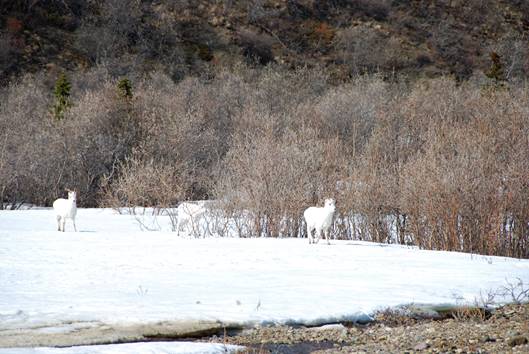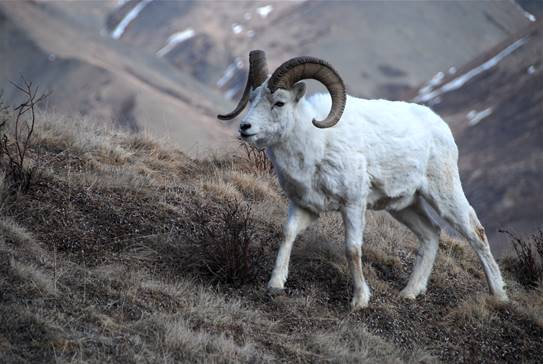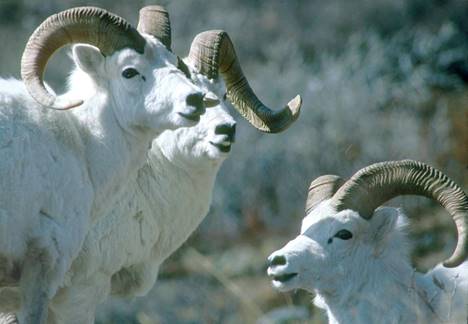Possessed of keen sight and scent, and strong limbs, he dwells secure amid the loftiest summits, leaping unscathed from crag to crag, up and down the fronts of giddy precipices, crossing foaming torrents and slopes of frozen snow, exposed to the wildest storms, yet maintaining a brave, warm life, and developing from generation to generation in perfect strength and beauty. – John Muir.
Dall sheep are native to northwest North America and they can be found in the subarctic mountain ranges of Alaska, the Yukon Territory, the western mountains of the Northwest Territories and northern British Columbia. They are the most northern wild sheep in North America.
Ovis – Latin for sheep, dalli – honors the naturalist William Healey Dall, an early explorer of Alaska. He explored the coast of Siberia aboard the Nightingale under the command of the naturalist Charles Melville Scammon. Though trained as a mollusk expert, as it was for the day he had a wide range of expertise. He had several exploratory trips to Alaska and enjoyed these so much he returned for his honeymoon in 1880.

Dall sheep have a white coat and the males have thick, curling horns. In contrast to Rocky Mountain bighorn sheep, Dall sheep have narrower, more delicate looking horns. Females have horns that are shorter and slightly curved. Horns are an extension of the animal’s skull covered with keratin, the same protein that makes up our fingernails and hair. Horns are a permanent, non-branching structure, as opposed to antlers, which are branched and grown and shed each year (think deer, elk, and moose).

The basic unit of the sheep social organization is the band. Adult bands are segregated by sex and one to several bands make up a herd. The size of the band varies with environmental conditions, habitat space, and distribution of various resources – water, mineral licks, forage, etc. In winter when habitat space is limited and bands are closer together, there are large fluctuations in the size of bands. One study concluded that the most efficient band size with respect to predator avoidance was five individuals. Little advantage in predator avoidance was provided by a larger group.
Ram (male) bands are largest in the spring and smallest during the rut when completion for ewes (females) is greatest. Ewe bands are largest after the spring lambing season and smallest during the fall rut. Rams are generally more solitary. The young rams will disassociate themselves from their band at about 2 years of age. The largest bands consist of ewes and lambs and may include up to 15 sheep.

Sheep are constantly on the move, foraging along in an aimless but steady manner. Fescue grass and sedges are the mainstay of Dall sheep forage. Willow, horseweed, and alpine fireweed are important food items in the spring and summer. Generally, sheep have two distinct, separate ranges in summer and winter with corresponding spring and fall migration. In the fall the ewes and lambs are the first to head to lower elevations and in the spring the pregnant ewes are the first to leave for the summer range, followed by the rams.
Gestation lasts 5.5 – 6 months with an average of 175 days. Lambing occurs between April and late June with the majority being born in late May. After birth the ewe will eat the placenta, a good protein source, after cleaning up their newborn. Within a day or two the youngsters are scampering around and climbing almost as well as mom. The most common way to age sheep is by counting their horn annuli – the annual growth rings on their horns, similar to tree rings.
Wolves are the primary predator for Dall sheep, though golden eagles, grizzly bear, and coyote are known to take sheep occasionally. I was talking to one of the Denali NP bus drivers once who told me I had just missed some action by the side of a road. A pack of wolves took down a Dall sheep and were munching away when a grizzly bear came lopping by and chased them off the kill. Dang.
Females are monestrous – coming into breeding condition only once per year. The rams will determine their social rank by jousting and head butting; the dominant sheep conducting the majority of the breeding. Breeding is polygamous with the rams moving freely among bands seeking out those ewes in estrus. Subordinate males will hang around waiting to see if the dominant male just gets tuckered out, and these youngsters will seize any chance to mate. Homosexuality is normal in North American wild sheep – the physical and behavioral characteristics of estrous ewes and young rams are quite similar, including submissiveness to mounting. This may be an adaptation that allows immature males to coexist with the dominant older rams.
Here’s a short video from the Kodachrome Hills in Denali National Park that gives you an idea of the habitat and the bus route on the only road into the park – you can just ask to get off and wander anywhere and flag down a bus for your ride back. Sheep on road
I’ve been up there a few times and during the early spring I was nearby for work and took a couple extra days to wander around. I hiked up ridge above the Kodachrome Hills and came across a band of sheep. So as not to disturb them I just sat on the ridge and watched. They just kept foraging along and slowly moved my way. After an hour they were all within 20 ft. or so, kept on munching away, I took some photos, and they slowly drifted down along the ridge the way I came up. I found another way down from my high perch so they would not think I was chasing them around.

